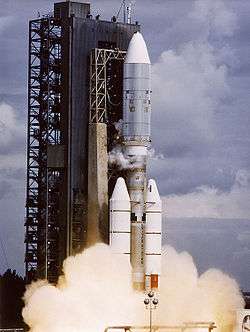1977 in spaceflight
Spaceflight in 1977 included some important events such as the roll out of the space shuttle orbiter, Voyager 1 and Voyager space probes were launched. NASA received the space shuttle orbiter later named Enterprise, on 14 January. This unpowered sub-orbital space plane was launched off the top of a modified 747 and was flown uncrewed until 13 August until a human crew landed the Enterprise for the first time.
 Launch of Voyager 2 on a Titan IIIE | |
| Orbital launches | |
|---|---|
| First | 6 January |
| Last | 27 December |
| Total | 130 |
| Catalogued | 124 |
| Rockets | |
| Maiden flights | Mu-3H Tsyklon-3 |
| Retirements | Kosmos-2I Titan IIIE |
| Crewed flights | |
| Orbital | 3 |
| Total travellers | 6 |
In August and September, the two Voyager spacecraft to the outer planets were launched. Voyager 2, launched on 20 August, went on to fly past Jupiter, Saturn, Uranus and Neptune. Voyager 1, which was launched on 5 September, flew past Jupiter and Saturn, with a planned flyby of Pluto being cancelled in favour of a closer flyby of Titan.[1]
Launches
| Date and time (UTC) | Rocket | Flight number | Launch site | LSP | ||
|---|---|---|---|---|---|---|
| Payload (⚀ = CubeSat) |
Operator | Orbit | Function | Decay (UTC) | Outcome | |
| Remarks | ||||||
| 16 June 10:51:00 |
||||||
| NOAA | Current: Graveyard Operational: Geostationary |
Weather | In orbit | Successful | ||
| Retired on 5 May 2001 and moved to a graveyard orbit | ||||||
| 20 August 14:29:44 |
||||||
| NASA | Heliocentric to Galactocentric | Planetary | In orbit | Successful Operational | ||
| Spacecraft flew past Jupiter, Saturn, Uranus and Neptune, first spacecraft to visit Uranus and Neptune | ||||||
| 5 September 12:56:01 |
||||||
| NASA | Heliocentric to Galactocentric | Planetary | In orbit | Successful Operational | ||
| Final flight of Titan IIIE, spacecraft flew past Jupiter and Saturn | ||||||
Deep Space Rendezvous
| Date | Spacecraft | Event | Remarks |
|---|---|---|---|
| 20 February | Viking Orbiter 1 | Flyby of Phobos | Closest approach: 89 kilometres (55 mi) |
| October | Viking Orbiter 2 | Flyby of Deimos |
EVAs
| Start Date/Time | Duration | End Time | Spacecraft | Crew | Remarks |
|---|---|---|---|---|---|
| 19 December 21:36 |
1 hour 28 minutes |
23:04 | Salyut 6 PE-1 |
First Russian EVA in over 8 years and the first use of the Orlan-D spacesuit.[2] Grechko inspected the front docking port for damage from the failed Soyuz 25 docking and found no damage, while Romanenko assisted from the open hatch. |
References
- Bergin, Chris. "NASASpaceFlight.com".
- Clark, Stephen. "Spaceflight Now".
- Kelso, T.S. "Satellite Catalog (SATCAT)". CelesTrak.
- Krebs, Gunter. "Chronology of Space Launches".
- Kyle, Ed. "Space Launch Report".
- McDowell, Jonathan. "Jonathan's Space Report".
- Pietrobon, Steven. "Steven Pietrobon's Space Archive".
- Wade, Mark. "Encyclopedia Astronautica".
- Webb, Brian. "Southwest Space Archive".
- Zak, Anatoly. "Russian Space Web".
- "ISS Calendar". Spaceflight 101.
- "NSSDCA Master Catalog". NASA Space Science Data Coordinated Archive. NASA Goddard Space Flight Center.
- "Space Calendar". NASA Jet Propulsion Laboratory.
- "Space Information Center". JAXA.
- "Хроника освоения космоса" [Chronicle of space exploration]. CosmoWorld (in Russian).